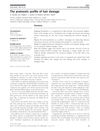TLDR Metabolomics can identify hair damage markers, but its use in creating treatments is uncertain.
The document discussed the application of metabolomics to study hair damage, highlighting the work of Joo et al., who used metabolomic statistical methods to analyze hair samples subjected to chemical treatments like bleaching, dyeing, and perming. They identified changes in amino acids, such as cysteine converting to cysteic acid, and alterations in tryptophan and methionine. Additionally, they produced a comprehensive hair lipid data set, revealing specific lipid changes correlating with the severity of hair damage. The study suggested that while metabolomics could identify biomarkers of hair damage, its potential to guide the development of antidamage treatments remained uncertain.
24 citations
,
April 2016 in “Experimental Dermatology” Chemical treatments like dyeing, perming, and bleaching damage hair by altering amino acids and lipids.
18 citations
,
January 2015 in “Experimental Dermatology” New mutations in KRT83 and KRT86 are linked to the hair disorder monilethrix.
 20 citations
,
June 2012 in “British Journal of Dermatology”
20 citations
,
June 2012 in “British Journal of Dermatology” Bleaching hair damages protein structure, especially keratin, leading to weakened hair.
 38 citations
,
October 2011 in “Analytical biochemistry”
38 citations
,
October 2011 in “Analytical biochemistry” Hair proteins have weak spots in their α-helical segments.
85 citations
,
October 2007 in “International Journal of Dermatology” Curly hair shape is due to uneven growth patterns in the hair follicle.
 12 citations
,
January 2020 in “Analyst”
12 citations
,
January 2020 in “Analyst” Researchers found markers that can tell if hair has been bleached, which could improve hair test accuracy.
 10 citations
,
September 2020 in “Metabolites”
10 citations
,
September 2020 in “Metabolites” Hair color and length affect metabolite profiles in hair, so they should be considered in hair analysis.
 August 2024 in “Applied Sciences”
August 2024 in “Applied Sciences” Plant extracts may help prevent or reverse hair graying.
 1 citations
,
July 2018 in “Elsevier eBooks”
1 citations
,
July 2018 in “Elsevier eBooks” Avoid chemical and physical damage to protect hair.
2 citations
,
July 2023 in “Cosmetics” Surfactants in shampoos and conditioners remove some but not all lipids from hair, and more research is needed to understand their full impact.





